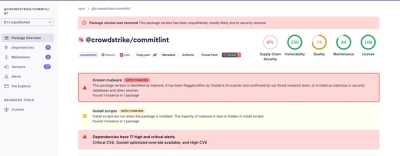
Research
Malicious fezbox npm Package Steals Browser Passwords from Cookies via Innovative QR Code Steganographic Technique
A malicious package uses a QR code as steganography in an innovative technique.
Painless yet High-Performance query and transaction execution for large-scale APIs
my-sql is a wrapper on the popular mysql package for easily executing mysql queries and transactions. The pain of managing connection pools and releasing connections after executing a query, is all taken care of internally. My-Sql also provides the ability to add custom middleware to modify the query and arguments dynamically.
This library by default exposes everything that mysql exposes. Thus you don't need to install mysql separately if you use my-sql.
In simple words, my-sql = mysql + awesome_features
npm install my-sql
The default export in this library is the original mysql package. All other exports of the mysql package
are also exported by my-sql without any modification.
Thus the migration involves only the following change; wherever you are importing something from the
original mysql package, just replace it with my-sql.
For example
import mysql, {createConnection, createPool} from 'my-sql';
... is identical to ...
import mysql, {createConnection, createPool} from 'mysql';
This library will always continue to be up-to-date with the original mysql package.
Please refer to the original docs to see what awesome things that npm mysql can do. Continue reading to see what additional methods we have included in this library.
First you need to create a session by providing db configurations. These are the same
configs that you would provide to create a connection pool using the mysql package.
import {initSession, executeQuery, executeTransaction} from 'my-sql'
initSession({
connectionLimit : 10,
host : 'example.org',
user : 'bob',
password : 'secret',
database : 'my_db'
});
Then you can simply execute queries or transactions on the my_db database.
executeQuery('SELECT * FROM test_table WHERE count > ? LIMIT ?', [100, 10])
.then((result)=>{
// Do something with the result array
})
.catch((err)=>{
// Some error has occurred
});
or multiple queries as an atomic transaction. We will take care of rolling back the transaction if something goes wrong and make sure that the result is consistent.
executeTransaction({
queries: [{
query: 'SELECT * FROM test_table WHERE 1 limit ?',
args: [10]
}, {
query: 'INSERT INTO test_table (ID, Name) VALUES (1234, ?)',
args: ["Dodan"]
}]
}).then((results)=>{
// Do something with the results array array (i.e: an array of result rows)
}).catch((err)=>{
// Some error has occurred
});
As of now all new methods send back data as promises. If you want us to provide support for callbacks, please open an issue in the github repository.
When using the executeQuery method, you can specify an options object as the
first argument instead of the query itself. All possible built in fields are listed below
{
"query": "SELECT * FROM ...",
"args": [],
"pool": "vipPool",
"lengthConstraint": 5555
}
For the executeTransaction method, you should anyway specify an object{query, args} array. The pool
and lengthConstraint arguments should be supplied after the {query,args} array.
you already know what query and args stand for. So let's talk about the other two fields.
When initializing the my-sql session by providing the database configs, we internally create a connection
pool. This is the default connection pool. It will be used whenever you don't specify a connection pool
explicitly. However, you can use the addInternalPool method to create any number of additional
connection pools. This is useful when you want to have different thresholds for different use cases.
If you don't understand why you need additional connection pools, you probably don't.
import {addInternalPool} from 'my-sql';
addInternalPool("vipPool", 5);
addInternalPool takes takes the form, addInternalPool(poolName, poolSize, [overrideConfig]). The optional
3rd argument is useful when the pool should be configured with database config which is different from the
one you specified in initSession method. It is worth noting that even the database can be different here.
Now that a pool with name vipPool is created, you can use it as follows.
executeQuery('SELECT * FROM test_table WHERE count > ? LIMIT ?', [100, 10], {pool: "vipPool"})
.then((result)=>{
// Do something with the result array
})
.catch((err)=>{
// Some error has occurred
});
or
executeQuery({
query: 'SELECT * FROM test_table WHERE count > ? LIMIT ?',
args:[100, 10],
pool: "vipPool"
})
.then((result)=>{
// Do something with the result array
})
.catch((err)=>{
// Some error has occurred
});
This parameter is useful when you have queries that group concat columns. When the concatenated string is too long, it can cause problems. So to avoid that you can specify the maximum number of characters that would be concatenated. The rest will be discarded.
You can pass in true as the lengthConstraint to use the default value of 5555 which is JSON parse-able.
One of the coolest things about this library is the ability to use custom middleware. A middleware in my-sql context is a function which dynamically modifies the arguments supplied to the query execution method. The function will basically accept the original options argument and will return a modified version of it.
A middleware is identified by a unique key or a name. Later, when you call the execute method with an options object containing one or more middleware keys, corresponding middleware will be activated.
Let's elaborate this with a trivial example.
Suppose you have have an optional variable count and based on its value, you want to do the following.
For this scenario you can break the query into two parts and append parts as necessary.
import {setMiddleware} from 'my-sql';
setMiddleware("countChecker", (options) => {
let {query, count, suffix} = options;
if (count > 10) {
query += ` AND COUNT > ${count} ` // Case 1
}
query += suffix; // Complete the query
if (count > 100) {
query += ' LIMIT 30'; // Case 2
}
options.query = query;
return options;
});
Now when you can call the execute method as follows to activate the middleware,
executeQuery({
query: "SELECT * FROM ABC WHERE VALUE > 4 ", // First part of the query
countChecker: true, // Activate the middleware
count: my_variable, // Variable required to modify the query
suffix: " GROUP BY CATEGORY " // Second part of the query
})
When the my_variable changes the resulting query will also change as follows,
"SELECT * FROM ABC WHERE VALUE > 4 AND COUNT > 15 GROUP BY CATEGORY ""SELECT * FROM ABC WHERE VALUE > 4 GROUP BY CATEGORY ""SELECT * FROM ABC WHERE VALUE > 4 AND COUNT > 15 GROUP BY CATEGORY LIMIT 30"If you don't want to use a middleware, you just simply ignore the key("countChecker" in this case).
But you can even remove the middleware at any time by calling the removeMiddleware method with
the corresponding key.
All connections, which are created internally, are sent back to the pool instead of destroying. That is, the methods exposed from this package are optimized. However, since the released connections are sent back to the pool without destroying, it will keep the NodeJs event-loop active.
Thus if all queries that are supposed to be run by the entire application are finished, you can call the endSession to destroy all connections in all pools. Yet we don't think this is required at all in a real world application since database operations will normally continue to run as long as the NodeJs server is running
import {endSession} from 'my-sql'
endSession();
FAQs
Painless yet High-Performance query and transaction execution for large-scale APIs
We found that my-sql demonstrated a not healthy version release cadence and project activity because the last version was released a year ago. It has 1 open source maintainer collaborating on the project.
Did you know?

Socket for GitHub automatically highlights issues in each pull request and monitors the health of all your open source dependencies. Discover the contents of your packages and block harmful activity before you install or update your dependencies.

Research
A malicious package uses a QR code as steganography in an innovative technique.

Research
/Security News
Socket identified 80 fake candidates targeting engineering roles, including suspected North Korean operators, exposing the new reality of hiring as a security function.

Application Security
/Research
/Security News
Socket detected multiple compromised CrowdStrike npm packages, continuing the "Shai-Hulud" supply chain attack that has now impacted nearly 500 packages.